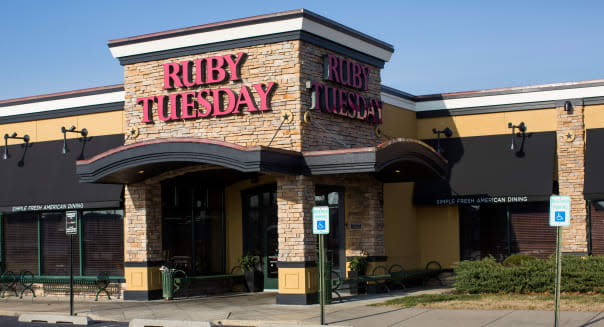Ruby Tuesday is Doing Even Worse Than Red Lobster

If you think Darden Restaurants (DRI) is struggling to get Red Lobster back on track, just imagine how much harder things must be for Ruby Tuesday (RT).
The struggling casual dining chain posted another dreadful quarterly report on Wednesday afternoon. Revenue from continuing operations fell 8 percent to $276.2 million in its fiscal second quarter, fueled primarily by a 7.8 percent slide in same-restaurant sales at company-owned locations. Excluding one-time accounting hits, Ruby Tuesday's net loss for the quarter from continuing operations widened to $25.9 million from $2.9 million a year earlier.
This is the second quarter in a row that Ruby Tuesday posts a much larger deficit than Wall Street was expecting. But why take analysts seriously in assessing the chain's struggles anymore? They have overestimated Ruby Tuesday's bottom line results in five of the past six quarters.
Ruby Tuesday is in a funk, and there may be no turning back now.
Rubies and Lobsters Are Red
Ruby Tuesday's grim report follows another stinker out of Red Lobster last month. Things are so bad at the country's largest seafood chain that Darden is looking to either sell off Red Lobster or spin it off so it doesn't hold the rest of its concepts back.
It wasn't pretty. Red Lobster's same-restaurant sales have slipped by 5.2 percent and 4.5 percent in its two most recent quarters. That was problematic enough for Darden to wave the surrender flag.
What do we then make of Ruby Tuesday's comps plummeting 7.8 percent and 11.4 percent in its two most recent reporting periods. Making matters worse, at least Darden is still quite profitable. Ruby Tuesday is showing no signs of returning to profitability.
Making Bread
Ruby Tuesday and Red Lobster are taking their fading popularity seriously. Red Lobster's plan was to add more non-seafood dishes to its menu in late 2012. %VIRTUAL-article-sponsoredlinks%Ruby Tuesday's been trying to mount a comeback by introducing pretzel bread burgers and flatbread pizzas at single digit price points.
It's not working, even though Ruby Tuesday is trying to argue otherwise.
"Our top priorities are driving increased guest counts and profitable sales growth," its CEO offered up three months ago, but the chain is failing on all three counts as traffic, sales growth, and profitability are all going the wrong way.
The chain is performing worse than where it was a year earlier, even after adding the new burgers and flatbreads in August, along with a marketing campaign. Three months ago Ruby Tuesday was expecting same-restaurant sales to turn positive by its fiscal fourth quarter. Now it doesn't see that happening at all this fiscal year. It's hoping that the November addition of hand-breaded chicken tenders can do the trick, but once again it's turning to something that several fast food and casual dining chains are already doing.
Goodbye Ruby Tuesday
The reinvention process isn't easy for restaurants. There aren't too many chains that have stormed back from such grim comps, especially in what is supposed to be an improving economy.
Ruby Tuesday is already staging a partial retreat. It plans to close 30 of its 779 restaurants in the coming months. It will simply not renew the leases on half of them and take a hit to close the other half prematurely.
Darden's in a bad spot with Red Lobster, but at least it has several other concepts that it can fall back on to see things through. Ruby Tuesday just has the 21-unit Lime Fresh chain beyond its namesake restaurants, and the small burrito roller hasn't been the shiny growth vehicle that Red Lobster thought it was initially buying.
A shakeout is coming, and if Red Lobster's going to be in for a world of hurt one can only imagine what the future holds for a retreating and profitless Ruby Tuesday.
Motley Fool contributor Rick Munarriz has no position in any stocks mentioned. The Motley Fool owns shares of Darden Restaurants.

